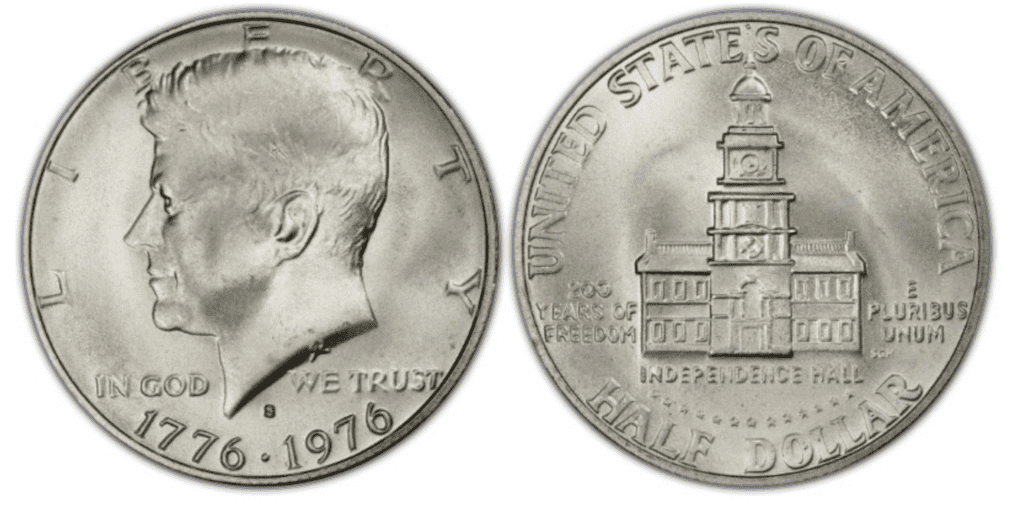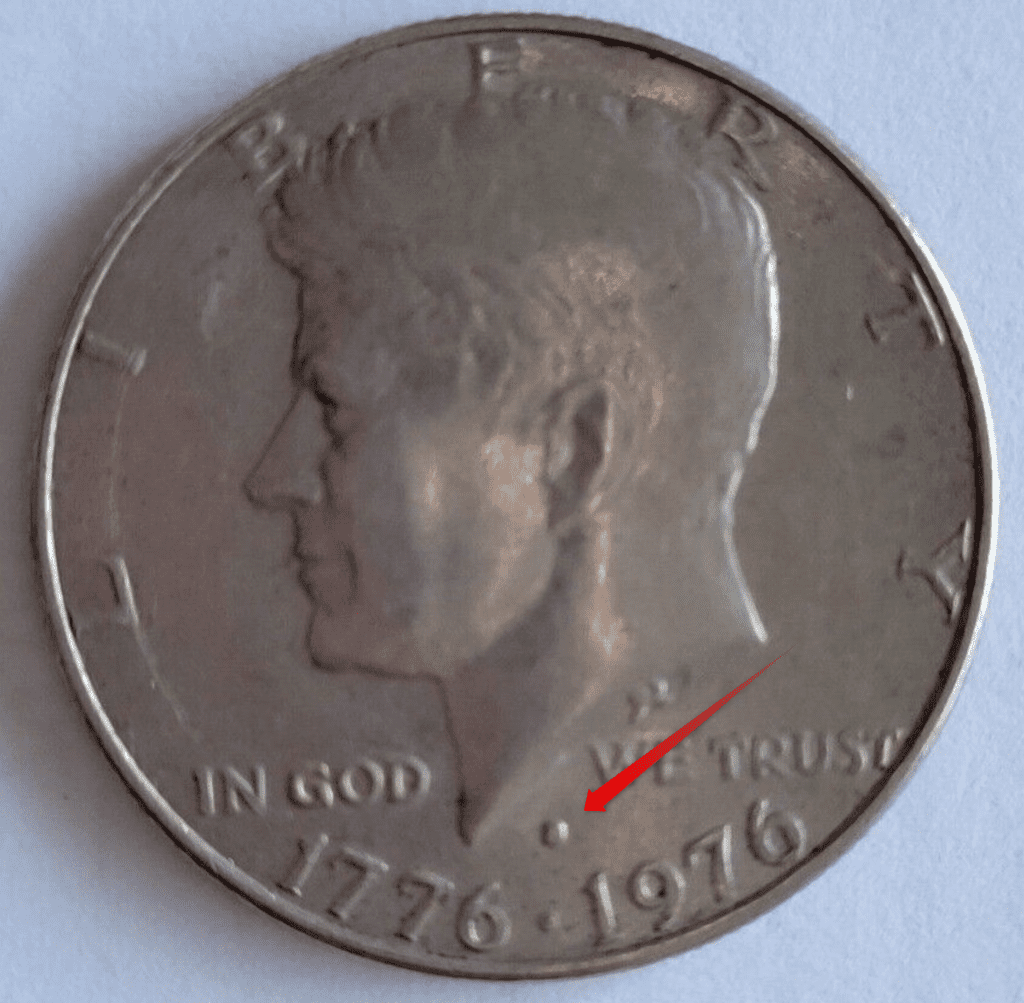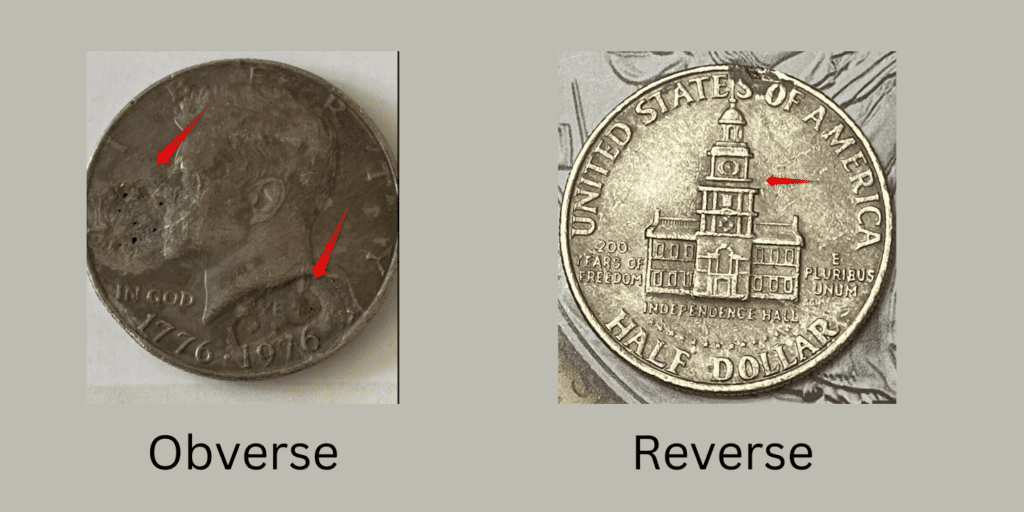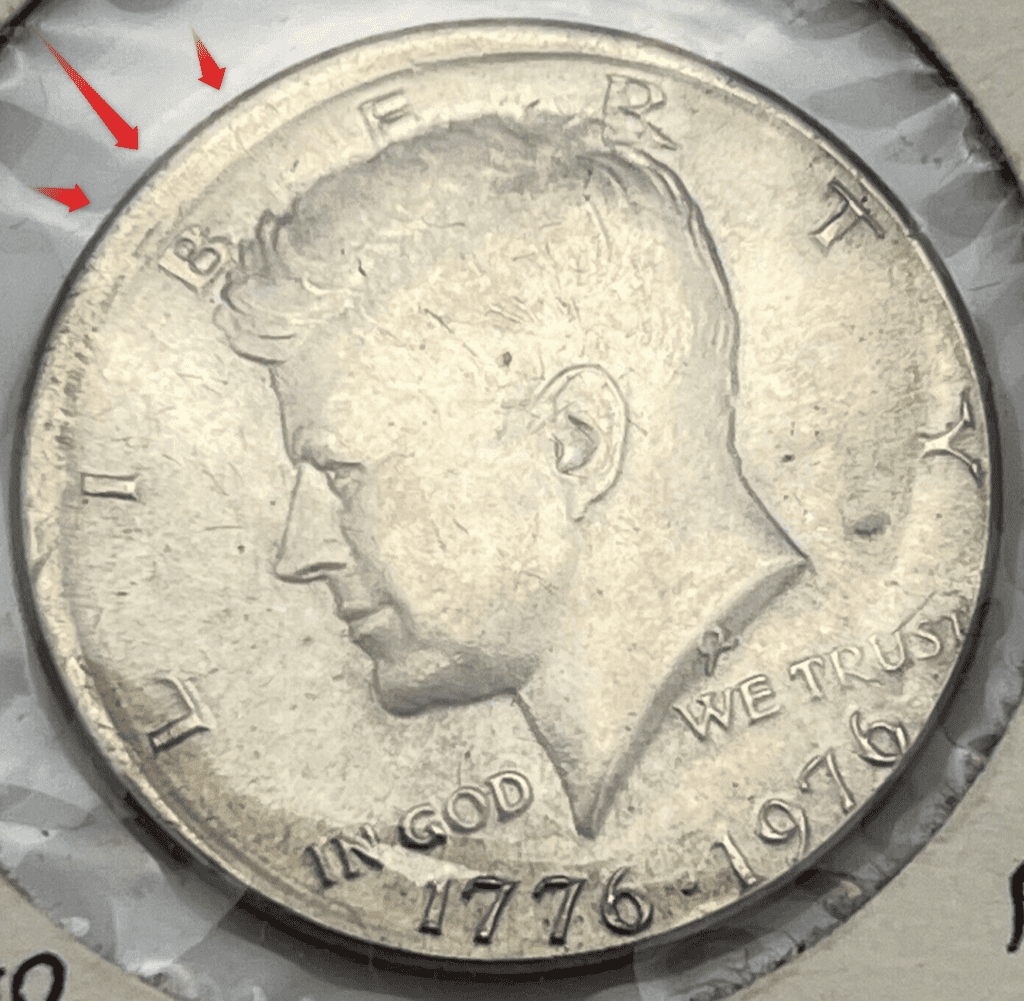What Is The 1976 Kennedy Half Dollar Made Of?
The 1976 half dollar is a special kind of coin because it coincides with the 200th anniversary of the United States Declaration of Independence. As a result, you don’t actually see a Kennedy half-dollar with only 1976 as its date; rather, what you’ll see is a double date, 1776-1976.
All half dollar coins minted in 1975 and 1976 bear the double date.

The 1976 dollar is a commemorative bicentennial coin with a unique reverse design. So, there are a few variations of the coin.
The standard 1976 dollar is made of 75% copper and 25% nickel. The core is copper while the coin is clad with nickel. However, you need to know that Congress in 1973 gave their approval to the U.S. Mint to produce a silver-clad version of the half-dollar coin.
Thus, you’ll also find 1976 half-dollar coins with 40% silver and 60% copper. This is similar to the half-dollar coins from 1965 to 1970, which were also 40% silver and 60% copper. In 1964, the half-dollar was made of 90% silver and 10% copper.
Today, the value of the 1976 half dollar is $0.50 cents. Its mass is 11.34 grams. The diameter is 30.6 millimeters and the thickness is 2.15 millimeters.
When it comes to the design, the obverse features the left profile of John F. Kennedy. Inscriptions include the following:
- LIBERTY – arched on top of the coin. Letters “B,” “E,” and “R” are slightly covered by Kennedy’s hair.
- IN GOD WE TRUST – written in a straight line below Kennedy’s portrait. However, the “God” and “WE” are divided by Kennedy’s neck.
- Mint mark (if present) – marks can be “D” or “S.” Mint marks can also be absent.
- Year – 1776-1976
Kennedy was sadly assassinated in 1963. The nation’s grief and mourning led to the redesign of the half-dollar. Thus, it now bears the portrait of the deceased president.
Gilroy Roberts, the previous U.S. Mint Chief Engraver, designed all the Kennedy half dollars obverse side. He based his design on President Kennedy’s inauguration medal.
On the reverse side, normally, you will see the presidential seal that features the familiar eagle. However, as mentioned above, the 1976 Kennedy half-dollar has a different design.
On the 1776-1976 Kennedy half-dollar, you’ll find Philadelphia’s Independence Hall. It’s a historic place where the second Continental congress meeting and Constitutional Convention were held. You’ll also find 13 small stars above the denomination.
Here are the inscriptions you’ll find on the reverse of the 1776-1976 Kennedy half-dollar:
- UNITED STATES OF AMERICA – arched on top of the coin.
- HALF DOLLAR – cradled at the bottom of the coin.
- 200 YEARS OF FREEDOM – located on the left side of the Independence Hall.
- E PLURIBUS UNUM – US motto, which means “Out of many, one.”
- INDEPENDENCE HALL – runs straight below the Independence Hall.
The reverse side of the commemorative 1976 coin was designed by Seth Huntington after winning the competition held by the U.S. Mint.
Is The 1976 Kennedy Half Dollar Silver?
Yes, the 1976 Kennedy half dollar is made of silver, but not all of them. As a special commemorative bicentennial coin, the U.S. Mint produced silver-clad half-dollar coins as well as nickel-clad coins. The silver version, which is 40% silver and 60% copper, was sold to coin enthusiasts and collectors while the copper-nickel version was added for circulation.
When it comes to its value, the silver and copper 1976 half dollar is worth around $3 with an MS 63 grade and $4 if it is in PR 65 condition.
1976 Kennedy Half Dollar Rarities And Varieties
There are different half dollar coins minted in 1976. Most of them differ based on their mint mark. Moreover, some coins also have some errors, making them rare and unique.
Here are some of the varieties you’ll find in the 1976 Kennedy half-dollar.
1970 D Nickel
Edge: Reeded
Mint Mark: S
Year: 1776-1976
Face Value: $0.50 USD
Price: $0.50 to $8.00 (or more)
Quantity produced: 7,059,000
Composition: 75% copper and 25% nickel
Mass: 11.34 grams
Diameter: 30.6 mm
Thickness: 2.15 mm

The 1976-S Kennedy Half Dollar was produced in the San Francisco Mint. A coin like this in the mint state can be sold for up to $8 or more.
1976-D Kennedy Half Dollar
Edge: Reeded
Mint Mark: S
Year: 1776-1976
Face Value: $0.50 USD
Price: $0.50 to $2.50 (or more)
Quantity produced: 287,565,000
Composition: 75% copper and 25% nickel
Mass: 11.34 grams
Diameter: 30.6 mm
Thickness: 2.15 mm

The 1976-D Kennedy Half Dollar was produced in the Denver Mint. A coin like this in the mint state can be sold for up to $2.5 or more.
1976-P Kennedy Half Dollar (No Mint Mark)
Edge: Reeded
Mint Mark: S
Year: 1776-1976
Face Value: $0.50 USD
Price: $3.50 to $2.50 (or more)
Quantity produced: 234,308,000
Composition: 75% copper and 25% nickel
Mass: 11.34 grams
Diameter: 30.6 mm
Thickness: 2.15 mm

The 1976 No Mint Mark Kennedy Half Dollar was produced in the Philadelphia Mint. A coin like this in the mint state can be sold for up to $2.5 or more.
1976 Silver Bicentennial Half Dollar
Edge: Reeded
Mint Mark: S
Year: 1776-1976
Face Value: $0.50 USD
Price: $0.50 to $220.00 (or more)
Quantity produced: 11,000,000
Composition: 40% silver and 60% copper
Mass: 11.50 grams
Diameter: 31 mm
Thickness: 2.15 mm

As a special and limited edition, the U.S. Mint produced a 1976-S 50-cent silver coin. A coin like this in circulated condition can be sold at $3.25 to $3.65. However, more impressive and appealing silver half-dollar coins can be sold at $220 or more.
List of Errors
No US coin has been free of errors and surely, the 1976 half dollar is not exempted. Throughout its production, there are some known errors. There are many examples of 1976 half-dollar errors, but here are three of them:
Filled mint mark

The mint mark isn’t as pronounced as it should be.
Multiple errors

This coin has a lot of errors in it. The planchet is damaged. The die cracked in Kennedy’s nap. The roof seems to be floating under the clock.
Off-center strike

The planchet wasn’t properly placed. Thus, when it was struck, the print was off the center.
How Much Is A 1976 Kennedy Half Dollar Worth Today?
The ordinary 1976 Kennedy half dollar has the same worth as its face value, which is $0.50 cents. Its melt value is the same as its face value. However, the silver version of the 1976 half dollar has a melt value of $2.85. So, it’s more valuable than its copper-nickel counterparts.
To give you an idea, here’s a table to get a quick look at the value of 1976 Kennedy half dollar:
| Coin | Condition | Grade | Price |
| Ordinary 1776-1976 half dollar coin | Circulated | Not graded | $0.50 |
| 1776-1976 half dollar with no mint mark | Uncirculated | MS 63 | $3.00 |
| 1776-1976 D half dollar | Uncirculated | MS 63 | $3.00 |
| 1776-1976 S proof half dollar | Uncirculated | PR 65 | $4.00 |
| 1776-1976 S silver half dollar | Uncirculated | MS 63 | $8.00 |
| 1776-1976 S silver proof half dollar | Uncirculated | PR 65 | $12.00 |
Please note that the price listed is just an indication. It can be higher depending on the condition of the coin.
Moreover, 1976 half-dollar coins with errors can be more expensive because of their rare and unique features.
How Does The Grading System Work?
The Sheldon Scale is used by numismatists to provide a numerical value to coins. The Sheldon Scale goes from poor (P-1) to perfect mint state (P-1) (MS-70). Coins were originally evaluated using words to reflect their condition (Good, Fair, Excellent, Etc.). Unfortunately, coin collectors and dealers had different ideas about what each of these terms represent.
Professional numismatists joined together in the 1970s and established CoinGrading standards. These numismatists now assign grades at key places on the seventy-point scale, using the most regularly utilized numeric points in conjunction with the original adjective grade. The following are the most common coin grades:
-
-
- (P-1) Poor – Indistinguishable and probably damaged; if used, must have a date and mintmark; otherwise, rather battered.
- (FR-2) Fair – Nearly smooth, but without the damage that a coin graded Poor often possesses. The coin must have enough detail to be identified.
- (G-4) Fair – Inscriptions have merged into the rims in some areas, and important elements have been mostly erased.
- (VG-8) Very Good- A little weathered, but all of the primary design elements are visible, albeit faintly. There is little if any, central detail left.
- (F-12) Good – The item is very worn, yet the wear is even, and the overall design details stand out clearly. Rims are almost completely isolated from the field.
- (VF-20) Very Fine – Moderately weathered, with some finer features still visible. The motto or all letters of LIBERTY are readable. Both sides of the coin have entire rims that are separated from the field.
- (EF-40) Extremely Fine – Gently used; all gadgets are visible, and the most important ones are bold. The finer details are bold and clear, however, light wear may be seen.
- (AU-50) Uncirculated – Slight evidence of wear on the coin’s design’s high points; may have contact marks; eye appeal should be adequate.
- (AU-58) Uncirculated Choice – Slight traces of wear, no severe contact marks, almost full mint shine, and great eye appeal.
- (MS-60) Mint State Basal – Strictly uncirculated; no indication of wear on the coin’s highest points, but an unsightly coin with reduced luster, visible contact marks, hairlines, and other flaws.
- (MS-63) Mint State Acceptable – Uncirculated, but with contact scratches and nicks, little reduced shine, but otherwise appealing appearance. The strike is weak to average.
- (MS-65) Mint State Choice – Uncirculated with great mint shine, very little contact blemishes, and exceptional eye appeal. The strike is unusually severe.
- (MS-68) Mint State Premium Quality – Uncirculated with superb luster, no obvious contact marks to the naked eye, and exceptional eye appeal. The strike is quick and appealing.
- (MS-69) Almost Perfect Mint State – Uncirculated with perfect brilliance, a sharp and appealing strike, and extremely good eye appeal. A near-perfect coin with minor imperfections in the planchet, strike, and contact markings (seen only under 8x magnification).
- (MS-70) Mint State Perfect – Under 8x magnification, there are no tiny imperfections discernible; the strike is crisp, and the coin is perfectly centered on a beautiful planchet. Rarely seen on a coin, this coin is bright and whole, with original luster and exceptional eye appeal.
-
Where To Buy 1976 Kennedy Half Dollar?
You can buy the 1976 Kennedy Half Dollar in antique stores and coin shops. Aside from that, these half-dollar coins can now easily be found on the Internet. Websites like Amazon and eBay have a lot of these coins.
You can also join the coin collectors club to meet people who are interested in collecting coins. They may point you in the right direction where you can get the best deals.
If you’re trying to determine the right coin for you, always check for certifications that would prove that the coin was properly assessed. Moreover, if you’re looking for silver half-dollar coins, you can check the reeds of the coin. It should be solid silver.
FAQs
Where is the mint mark on the 1976 Kennedy half dollar?
The mint mark on the 1976 Kennedy half dollar is found on the cut-off line of Kennedy’s neck. You can find the mint mark between the truncation of the “IN GOD” and “WE TRUST” letters. Mint marks can be a “D” for Denver and an “S” for San Francisco. No mint mark for coins minted in Philadelphia.
What is the error on 1776-1976 Kennedy half dollars?
There are different types of errors that have been noticed. Some errors include blank planchet, doubled die, broad strike, weak strike, broken die, and off-center strike, to name a few.
What makes the 1976 half dollar so valuable?
The 1976 half dollar dramatically increases its value if it is rare and unique. Moreover, it has special features that make it more appealing and desirable. Some 1976 half-dollar coins were sold for as much as $200.
What is the mark on Kennedy’s neck on the half dollar?
The mark on Kennedy’s neck can either be the engraver’s initials or the mint mark. On Kennedy’s neck, the initial is written as a stylized monogram formed from the “GR” initials, which stands for Gilroy Roberts.
The other mark found on Kennedy’s neck is the mint mark, which is located between the “IN GOD” and “WE TRUST” inscriptions. Mint marks can be D or S. It can also be absent.
